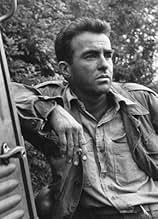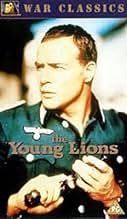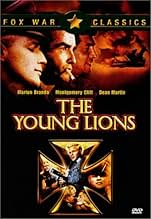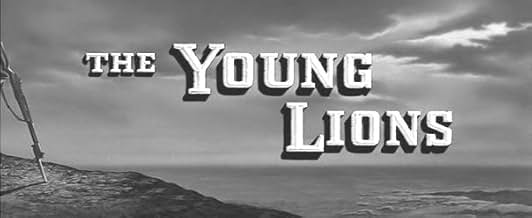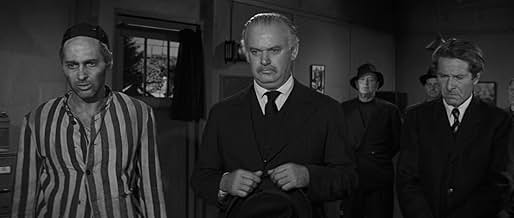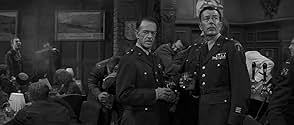NOTE IMDb
7,1/10
9,4 k
MA NOTE
La vie de trois jeunes hommes, un Allemand et deux Américains pendant la 2eme Guerre Mondiale.La vie de trois jeunes hommes, un Allemand et deux Américains pendant la 2eme Guerre Mondiale.La vie de trois jeunes hommes, un Allemand et deux Américains pendant la 2eme Guerre Mondiale.
- Réalisation
- Scénario
- Casting principal
- Nommé pour 3 Oscars
- 1 victoire et 7 nominations au total
John Alderson
- Cpl. Kraus
- (non crédité)
John Banner
- German Town Mayor
- (non crédité)
Stephen Bekassy
- German Major
- (non crédité)
Avis à la une
"The Young Lions" is a black & white 1958 WW2 drama featuring Marlon Brando, Dean Martin and Montgomery Clift.
The film attempts to show the German, American and French sides of the war. Brando stars as a young German officer who becomes increasingly disillusioned with Hitler's regime and the world war he started. Meanwhile Martin plays a worldly Broadway musician who struggles with cowardice whereas Montgomery Clift's character is a poor, naive Jewish American who falls in love with with a winsome lass (Hope Lange) and fights the anti-semitic guys in his platoon.
Marlon's performance illustrates why he's considered the greatest actor in cinema; he's just captivating. Most reviewers note that Brando's German storyline is more interesting than the two American story lines, which is true, but repeat viewings grant the viewer more appreciation for the latter.
There are three stunning women featured in the picture: Barbara Rush, May Britt and Liliane Montevecchi. Rush is Martin's marriage-minded gal, who flirts with Brando early on; Britt plays the luscious sexpot wife of Brando's captain (Maximilian Schell); and Montevecchi performs as a French girl who initially insults Brando's character (because he's a German invader).
It should be pointed out that "The Young Lions" is not a war action film, but rather a powerful war DRAMA. Yes, there's quite a bit of action (France, Northern Africa, etc.), but the emphasis is on the characters and their stories. The climax involves a horrified and utterly disillusioned Brando, leaving a strong impact.
FINAL WORD: If you're looking for a mindless action flick this is not the one to see. This perhaps explains some of the less-than-stellar reviews. Yet, make no mistake, "The Young Lions" is without a doubt a WAR film. It's also a masterpiece of cinematic art, not to mention one of Brando's most mesmerizing performances.
The film runs 2 hours, 47 minutes.
GRADE A-
The film attempts to show the German, American and French sides of the war. Brando stars as a young German officer who becomes increasingly disillusioned with Hitler's regime and the world war he started. Meanwhile Martin plays a worldly Broadway musician who struggles with cowardice whereas Montgomery Clift's character is a poor, naive Jewish American who falls in love with with a winsome lass (Hope Lange) and fights the anti-semitic guys in his platoon.
Marlon's performance illustrates why he's considered the greatest actor in cinema; he's just captivating. Most reviewers note that Brando's German storyline is more interesting than the two American story lines, which is true, but repeat viewings grant the viewer more appreciation for the latter.
There are three stunning women featured in the picture: Barbara Rush, May Britt and Liliane Montevecchi. Rush is Martin's marriage-minded gal, who flirts with Brando early on; Britt plays the luscious sexpot wife of Brando's captain (Maximilian Schell); and Montevecchi performs as a French girl who initially insults Brando's character (because he's a German invader).
It should be pointed out that "The Young Lions" is not a war action film, but rather a powerful war DRAMA. Yes, there's quite a bit of action (France, Northern Africa, etc.), but the emphasis is on the characters and their stories. The climax involves a horrified and utterly disillusioned Brando, leaving a strong impact.
FINAL WORD: If you're looking for a mindless action flick this is not the one to see. This perhaps explains some of the less-than-stellar reviews. Yet, make no mistake, "The Young Lions" is without a doubt a WAR film. It's also a masterpiece of cinematic art, not to mention one of Brando's most mesmerizing performances.
The film runs 2 hours, 47 minutes.
GRADE A-
I have seen this movie several times and catch something different every time I see it. Today is the first time I've seen it from the beginning. In the context of the time it was made, it was a bold statement about the human factor in any war. Brando shines and plays a sympathetic character who sees first hand the evil that men do in the name of patriotism.
Made at a time when the Americans that liberated the concentration camps were in their prime and there weren't any idiots running around claiming it was a lie, we see how ordinary citizens respond to the unthinkable. Brando's character stands in for the citizens of the Reich who claimed they were clueless about the genocide while the ashes from the smokestacks fell like snow on their towns. We see the horror and the denial.
It briefly explores a major taboo--interracial/interfaith marriages. It looks at racism in the context of anti-Semitcism (unfortunately still alive and well in America) and one man's courage in opposing it. Ironic this brand of racism, as the founder of the prevelant religion in America was a Jewish rabbi.
This movie is worth the 3 hours of time; it would make a great set piece with "Judgement at Nuremberg" which also showcases the talents of many of the actors from this film.
Good acting from all players in this film. It presages Robert Altman with the interweaving of the characters' lives from the first shot where Barbara Rush and Brando debate the merits of the Fatherland to the last scene in the forest where the end comes full circle.
Made at a time when the Americans that liberated the concentration camps were in their prime and there weren't any idiots running around claiming it was a lie, we see how ordinary citizens respond to the unthinkable. Brando's character stands in for the citizens of the Reich who claimed they were clueless about the genocide while the ashes from the smokestacks fell like snow on their towns. We see the horror and the denial.
It briefly explores a major taboo--interracial/interfaith marriages. It looks at racism in the context of anti-Semitcism (unfortunately still alive and well in America) and one man's courage in opposing it. Ironic this brand of racism, as the founder of the prevelant religion in America was a Jewish rabbi.
This movie is worth the 3 hours of time; it would make a great set piece with "Judgement at Nuremberg" which also showcases the talents of many of the actors from this film.
Good acting from all players in this film. It presages Robert Altman with the interweaving of the characters' lives from the first shot where Barbara Rush and Brando debate the merits of the Fatherland to the last scene in the forest where the end comes full circle.
More than a passing resemblance exists between Clift's Noah and the Robert E. Lee Prewitt of 'From Here to Eternity.' They are both "hard heads,' determined to live by their own special code of honor
The chief difference is that Noah is not alone
Throughout the film, he is accompanied by a friend, who has a number of reasons to be against the war
Also Noah gets the girl of his dreams
He even marries her
'The Young Lions' retains its impact as one of the better films made about war... The combat scenes are limited in scale but brilliantly staged and photographed, with good direction of a complex script and a masterly musical score by Hugo Friedhofer
Director Dmytryk never misses an opportunity to underline how war comes into collision with the destinies of people When Brando encounters May Britt - as the wife of his superior officer, Maximilian Schell - she is the perfect image of Nazi vices: Corrupt, hedonistic, and, of course, condemned along with the rest of the decadent Germans Her hazardous beauty is used as counterpoint to Brando's enthusiasm and beliefs: She represents all that is bad and immoral while he is everything noble and pure
Dmytryk is less awkward depicting the relationship between Clift and Lange: Their Love is a natural condition They belong together Like Robert E. Lee Prewitt, Clift's Noah is ill-at-ease socially When he meets Lange, his reaction is clear, spontaneous, purposeful, direct He begins to babble a lot to make an impression on her, because, as he tells her later, "I was afraid that if I was myself you wouldn't look at me twice." But Hope was gracious enough to attend the guy The young nice girl has at last found her favorite kind of hero
Clift, who finds himself standing up for his rights and for principles he did not even know he had, pared his lines to the minimum needed to convey the essence of Noah Ackerman The prison sequence is a clear and simple proof of it The emotional urgency of the young couple is communicated through looks, small gestures, and soft and tender words of love and caring
Nominated for Best Cinematography, Best music and Best Sound, Dmytryk's motion picture is a moving and eloquent statement of how war collides with the destinies of people and hurls them into a maelstrom
'The Young Lions' retains its impact as one of the better films made about war... The combat scenes are limited in scale but brilliantly staged and photographed, with good direction of a complex script and a masterly musical score by Hugo Friedhofer
Director Dmytryk never misses an opportunity to underline how war comes into collision with the destinies of people When Brando encounters May Britt - as the wife of his superior officer, Maximilian Schell - she is the perfect image of Nazi vices: Corrupt, hedonistic, and, of course, condemned along with the rest of the decadent Germans Her hazardous beauty is used as counterpoint to Brando's enthusiasm and beliefs: She represents all that is bad and immoral while he is everything noble and pure
Dmytryk is less awkward depicting the relationship between Clift and Lange: Their Love is a natural condition They belong together Like Robert E. Lee Prewitt, Clift's Noah is ill-at-ease socially When he meets Lange, his reaction is clear, spontaneous, purposeful, direct He begins to babble a lot to make an impression on her, because, as he tells her later, "I was afraid that if I was myself you wouldn't look at me twice." But Hope was gracious enough to attend the guy The young nice girl has at last found her favorite kind of hero
Clift, who finds himself standing up for his rights and for principles he did not even know he had, pared his lines to the minimum needed to convey the essence of Noah Ackerman The prison sequence is a clear and simple proof of it The emotional urgency of the young couple is communicated through looks, small gestures, and soft and tender words of love and caring
Nominated for Best Cinematography, Best music and Best Sound, Dmytryk's motion picture is a moving and eloquent statement of how war collides with the destinies of people and hurls them into a maelstrom
A long time ago, some time before the powers that be decided that movies should be made only to extricate money from children by catering to their base instincts and in so doing destroy our civility, the American Cinema was devoted to the art and craft of story telling. In these stories, life was often celebrated through the study of the character of the human heart.
In THE YOUNG LIONS, we experience masterful story writing in the screenplay by a man named Edward Anhalt who adapted it from a novel by Irwin Shaw. In this fine example of the final years of the Golden Age of Hollywood we see a study of character, ideas and humanity seen amidst the greatest conflict this Earth has ever known, WWII.
Here, we experience both the Americans and Europeans, including Germans. They are played as they really were, not as depicted by latter day directors such as Steven Spielberg and others who have drawn WWII Germans as silhouette, cartoon characters, all vile and evil. Here, they are shown as singular human beings with personalities, hopes and dreams really exactly like our own. The opposing forces are caught up in a madness that somehow swept across the face of this planet at a specific time, when really probed, for reasons quite unfathomable. This was also one of the peak film renderings of Marlon Brando, whom some feel is one of the finest actors ever to have graced the silver screen.
If you yearn for a fulfilling example of American Cinema at a time when it was a serious, respected industry, this is one for you to see.
In THE YOUNG LIONS, we experience masterful story writing in the screenplay by a man named Edward Anhalt who adapted it from a novel by Irwin Shaw. In this fine example of the final years of the Golden Age of Hollywood we see a study of character, ideas and humanity seen amidst the greatest conflict this Earth has ever known, WWII.
Here, we experience both the Americans and Europeans, including Germans. They are played as they really were, not as depicted by latter day directors such as Steven Spielberg and others who have drawn WWII Germans as silhouette, cartoon characters, all vile and evil. Here, they are shown as singular human beings with personalities, hopes and dreams really exactly like our own. The opposing forces are caught up in a madness that somehow swept across the face of this planet at a specific time, when really probed, for reasons quite unfathomable. This was also one of the peak film renderings of Marlon Brando, whom some feel is one of the finest actors ever to have graced the silver screen.
If you yearn for a fulfilling example of American Cinema at a time when it was a serious, respected industry, this is one for you to see.
Lt. Christian Diestl (Marlon Brando) is a dutiful German who finds the war more and more troubling. Meanwhile back in the US, Jewish Noah Ackerman (Montgomery Clift) finds love, and entertainer Michael Whiteacre (Dean Martin) try to avoid the war.
This movie is split in three. I find the Marlon Brando part very intriguing right from the start. A straight movie with just his character would be very interesting. Brando sets a serious compelling tone. Clift and Martin's movie starts slowly. Quite frankly, it starts as an old fashion melodramatic romance with puppy dog Montgomery Clift. Martin has even less to do as he debates whether to join the fight or not. The movie crawls along at times, and would probably be better served to just keep Brando. Although Clift has some minor drama. At 167 minutes, this is like 2 movies jammed into one. The connection between the stories is tenuous at best until the very end. It seems it took forever to get there. Once there, the point of the movie is made crystal clear, but it seems that it could have been done with a much tighter story.
This movie is split in three. I find the Marlon Brando part very intriguing right from the start. A straight movie with just his character would be very interesting. Brando sets a serious compelling tone. Clift and Martin's movie starts slowly. Quite frankly, it starts as an old fashion melodramatic romance with puppy dog Montgomery Clift. Martin has even less to do as he debates whether to join the fight or not. The movie crawls along at times, and would probably be better served to just keep Brando. Although Clift has some minor drama. At 167 minutes, this is like 2 movies jammed into one. The connection between the stories is tenuous at best until the very end. It seems it took forever to get there. Once there, the point of the movie is made crystal clear, but it seems that it could have been done with a much tighter story.
Le saviez-vous
- AnecdotesMontgomery Clift was widely felt to look too old and unhealthy to be an A1 soldier. Although Clift was only 36 during filming, this was the first full film he had made since his near-fatal 1956 car accident (it occurred during filming of L'arbre de vie (1957)), which had drastically altered his appearance.
- GaffesEarly in the movie, Marlon Brando's character is riding in some sort of staff car. The car is right-hand drive; the Germans did not use right-hand drive. However, the staff car is a French-made Laffly V15T, which is, indeed, right-hand drive and was used by the French Army in WWII. The vehicle was probably captured from the French Army.
- Citations
Michael Whiteacre: You want me to get shot. Look, I've read all the books. I know that in 10 years we'll be bosom friends with the Germans and the Japanese. Then I'll be pretty annoyed that I was killed.
- ConnexionsFeatured in V.I.P.-Schaukel: Épisode #8.2 (1978)
Meilleurs choix
Connectez-vous pour évaluer et suivre la liste de favoris afin de recevoir des recommandations personnalisées
Détails
- Date de sortie
- Pays d’origine
- Langues
- Aussi connu sous le nom de
- La ira de los dioses
- Lieux de tournage
- Société de production
- Voir plus de crédits d'entreprise sur IMDbPro
Box-office
- Budget
- 3 550 000 $US (estimé)
- Montant brut mondial
- 9 363 $US
- Durée
- 2h 47min(167 min)
- Couleur
- Mixage
- Rapport de forme
- 2.35 : 1
Contribuer à cette page
Suggérer une modification ou ajouter du contenu manquant


